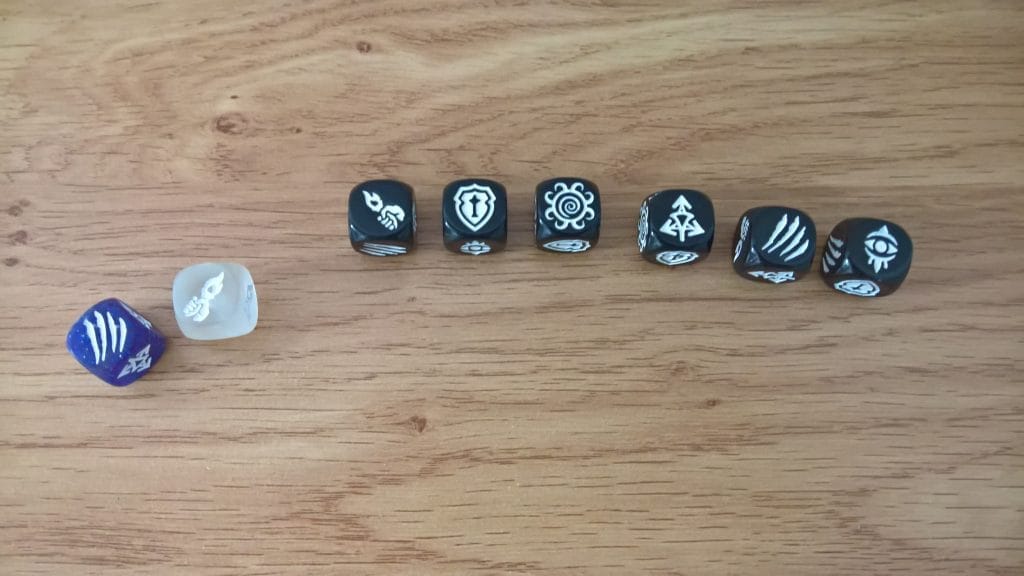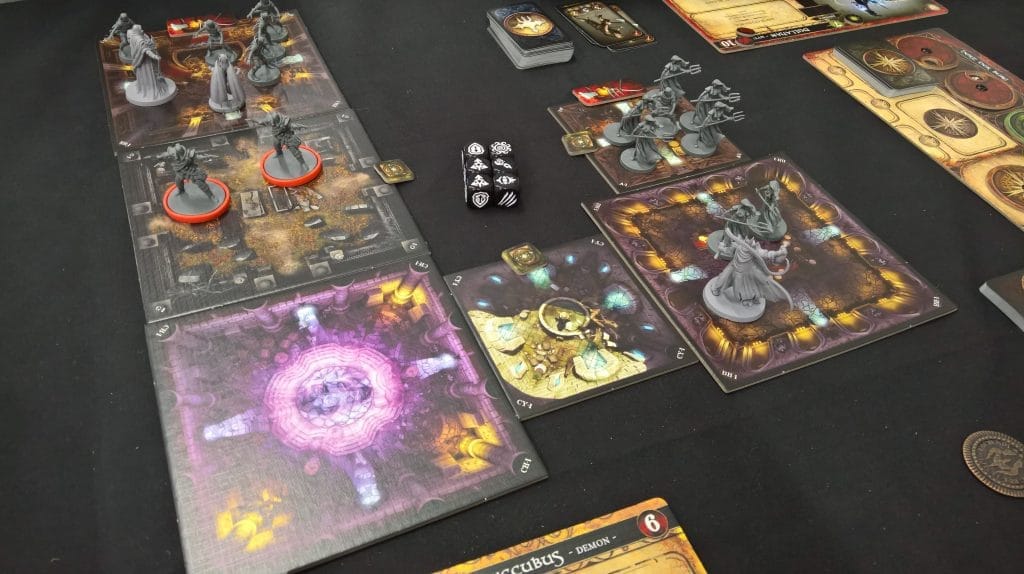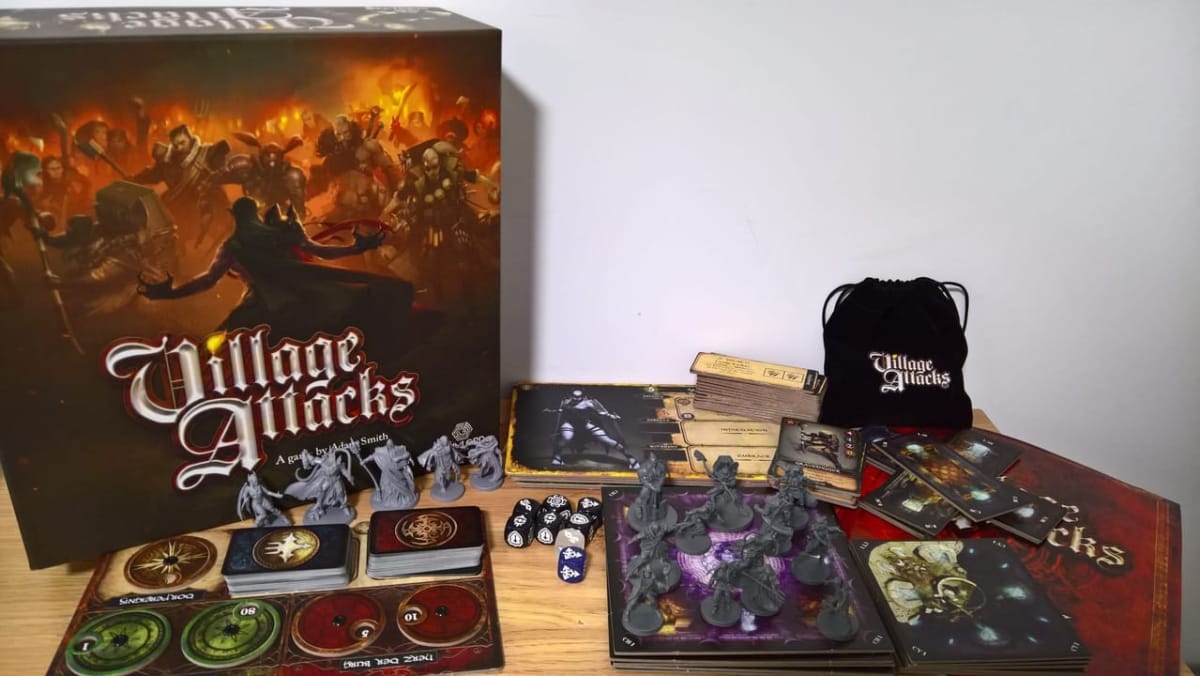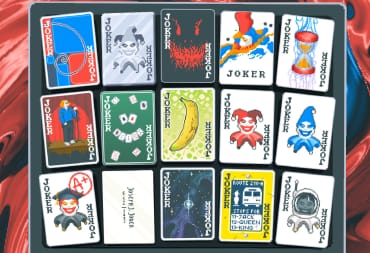This week our On The Tabletop report is on Grimlord Games' Village Attacks. Village Attacks comes into retail from a very successful Kickstarter that had a lot of content, so we could see a lot of expansions over the next few months.
In Off The Shelf we will look at what's in the box along with covering how the game plays. This will be followed by On The Tabletop where we will talk about our first playthrough games and finish with feedback from the On The Tabletop team.
The On The Tabletop play-through articles catalogue our initial experiences with a game; as a result, mistakes will be made. On The Tabletop should also not be taken as a full review. These articles are simply our first impressions of a game.
Off The Shelf
A huge bulk of the Village Attacks' box is taken up by the 66 miniatures it contains. The miniatures are a soft plastic, so some bending may have taken place in the box, but this can be fixed by simply holding your mini in hot water, bending it back into shape and then dipping it in cold water to set the plastic again. The sculpts for the miniatures are great—the Monsters especially are full of character and the Town Heroes have great motion. The remaining nameless villagers make up the pestering hordes taking an aggressive stance against your castle.[gallery columns="4" size="large" ids="269834,269833,269832,269831"]
The rest of the box is made up of the map tiles, card decks, tokens, monster play boards, and dice. It also contains a coin that's used to mark the first player and also flipped to decide the outcome of villager movement and attacks when there is more than one option. The final component is a fabric bag that's used to randomize the monster hunting speciality of the Hunters and is also great for storing all the game's tokens between games.
[gallery size="large" ids="269835,269836,269840"]
Village Attacks is a cooperative defence game, where players take on the roles of mythical monsters of legend and defend their castle against an angry mob of villagers who have had enough of living in fear of the monsters on their doorstep.
Games of Village Attacks take place over turns split into three phases, which are:
- Monster phase - Where players roll dice and complete actions
- Villager phase - Where the AI controlled villagers push through the castle, attacking the monsters and seeking out the Castle Heart
- Clean up phase - The end phase where cards are discarded and board elements refreshed before the next turn starts
The six dice faces are:
- Melee attack - lets a monster deal 1 damage to a villager in their map tile
- Ranged attack - lets a monster deal 1 damage to a villager in an adjacent map tile
- Defence - protects a monster from damage from villagers
- Retaliate - lets a monster deal damage back to a villager after they have taken damage
- Magic - For use in powers and abilities
- Villager movement - Makes a villager the furthest away from the castle heart move 1 map tile closer

Players can use any of the dice rolled, except the villager movement action, to move their monster one map tile. The villager movement face effectively blocks an action for the player, and moves a villager furthest away from the Castle Heart one map tile closer towards their goal. The dice rolled can be used in any order, so villagers moving can sometimes be used to the player's advantage, The Succubus can choose which villager moves, which allows players to effectively position villagers to be attack by other monsters or move them into traps.
On the monster's playboards, there are three types of boxes that restrict certain actions to the amount of boxes they have. Monsters can save defence dice, which are used during the villager phase. They do this by exchanging a dice for a counter of the same type, which is placed on the space on their playboard and is discarded after use, or at the end of the turn. Dice faces can also be placed in a reserve, which means that you roll one less dice next turn, but giving you access to that result, effectively guaranteeing that you have that dice face next turn. This allows you to plan for future turns and set ambushes for the villagers, possibly building up a lot of melee attacks that can't be used due to villagers being too far away.
[gallery columns="2" size="large" ids="269839,269837"]
Players can also buy traps by spending a matching dice face. Traps are placed in the map tile the monsters is currently in and is then set off during the villager phase as villagers move into it.
During the villager phase, villagers deal damage to a monster in the same map tile as them, and then move towards the castle heart. More villagers then spawn at set locations by drawing cards from the villager deck. Each villager deals a set amount of damage to a random monster in the same room, with the amount of damage depending on their villagers type.
There are three different types of villagers; peasants, who deal one damage each and only take one damage to remove, they are only really dangerous in large volumes. Hunters, who have a randomised type to match one of the monsters in play. Hunters are the same as peasants unless they are attacking a monster matching their speciality, when they cause more damage. The last type of villagers are Town Heroes. These are elite hunters and have their own stats card. Town heroes can deal a solid amount of damage, take more damage back than regular villagers and also have their own special abilities.
Village Attacks comes with 14 scenarios, but there are a few optional rules that can also be added in to games as required. Day and Night phases for example make it alternatively harder and then easier for the monsters, restricting actions depending on the phase, and also replacing one of the six dice with a day/night dice depending on the phase. Several copies of the Troll! event card can also be shuffled in to the event deck. The Troll is an equal opportunity weapon, attacking any monsters and villagers in its way without prejudice after it spawns.
On The Tabletop
This week we only had three members of On The Tabletop team, but it was perfect as the Village Attacks scenarios are designed for 3 monsters. More players can be added or lost and certain things scale as a result.Village Attacks has 14 scenarios, which all list the difficulty and rough time to complete. The first four scenarios are tutorials, which add in mechanics with each game. We started with scenario 1, to get all of us into the game first. All scenarios begin with setting up the map with the room tiles, which was surprisingly quick for our first game as the map tiles are clearly marked and easy to read. With the amount of components, it was good to be almost into the game straight away as we expected it to take a lot longer to set up. We did have a large selection of miniatures and tokens off to one side, so a fair amount of table space was required, even for the small map.
Next we each selected our monsters. Each monster has a role, and you're allowed only 1 Guardian and Decimator. Lizi chose the Lich (our Decimator), Sam chose the Dullahan as our tank (Guardian) and I chose the Succubus for some villager control (Support).

The first scenario, Lessons of the Past is very straight-forward. Villagers spawn from two locations with direct routes to the Castle Heart. If a villager reach the Castle Heart, the players lose and all the players have to do is level up each monster once and then finish off any remaining villagers. Each villager removed awards 1 experience point. Both the Lich and Succubus require 5 experience points to level up and Dullahan requires 7. So all we needed to do was eliminate 17 villagers, and then any remaining.
The first few turns were spent working out timing and dice roll mechanics, but we soon settled into a system of movement and attacks. Dullahan is very much a tank, and was able to barrel down one of the corridor branches and deal with the spawning villagers solo. The Lich and Succubus took the other corridor branch and dealt with the villagers spawning there. In the introductory scenario, it feels like a lot of villagers spawn very quickly, but they offer very little threat to the monsters, who are able to take out several between them a turn. Once we had all levelled up, it was quick work to finish off those remaining.
We found that placing the dice on the movement part of the monster's playboard was essential to remember how much they had moved. It was very easy when working out best practice to accidently move several times when trying to work out the best way to eliminate the villagers rushing towards the centre of your castle.
[gallery columns="2" size="large" ids="269842,269843"]
The second scenario, Fates Entwined, provides a much bigger map to play on and also introduces villager events. We dealt with this scenario with the same tactics as the first, and Dullahan shambled off to deal with one villager spawn branch, while the Lich and Succubus dealt with the other. We were able to play around much more with the monster's own special abilities in this scenario as the larger map gives a lot more room to play with.
We started using the Monster's reserves in this scenario a lot more, as we worked very closely together to position villagers and monsters for best placed removal. We did notice that it was very easy to forget about your reserve, and just roll the six dice straight away, only noticing the reserve when you went to put dice on the playboard, so we got into the routine of checking the reserve, removing the token and setting one dice face to match, and putting it aside. We found that worked much better than the token/dice rolling combination as you could also reroll tokens if they matched.
[gallery columns="2" size="large" ids="269844,269845"]
The second scenario begins using villager events periodically throughout the game, and our first event was unlucky, which meant that all attacks coming from rooms have a 50% chance of failure (only rooms, not corridors) so this added an extra element of tactics and thought through the rounds.
We blasted through the second scenario once we had found our rhythm and upgraded our monsters. There was a point where if the Lich had moved out of the tile with the Succubus, the Succubus would have taken the wrath of six villagers and died, but the Lich stayed to share the damage and we were able to take out the last couple of villagers to win the scenario. The second scenario doesn't use Town Heroes, which is where the real challenge lies with Village Attacks, but we didn't have any more time during our On The Tabletop session to experience that side of the game.
Player Thoughts
[gallery ids="264469,264471,267469"]Adam - I've never been a huge fan of defence games with fixed enemy AI movement and attacks and I've had some interesting conversations about playing these types of games with Alpha gamers, where it stops being a co-op game. The first game I enjoyed with this kind of mechanic was Walking Dead All Out War, which changed my opinion of the mechanics. Village Attacks appealed to me because of the theme and the shambling AI mechanics work well because of it. You play the monsters and I love the idea that the villagers are almost an irrelevance to the legendary creatures. The villagers all look and act the same to the long lived monsters and eliminating them is a matter of removing insects from their house.
The game itself was easy to set up, but some of the dice mechanics felt a bit fiddly. When I was reading through the rulebook prior to the game, it felt like a visual King Of Tokyo (which only has two locations) mixed with Zombicide. But when we started playing, the dice didn't feel as smooth or fast paced to me as King of Tokyo and the reserve mechanic, while interesting, felt like it slowed the pace down. I think I would have preferred a much more streamlined system of being able to use any dice (except the Villager face) for movement with no reserve. It would take away some of the complexity of the game, but would make the turns quite punchy.
The monsters and their abilities are fantastic and while the Succubus stood out as my favourite, I think I would enjoy playing any of them. Each one feels very thematic and their actions feel very in-keeping, which for me is very important. Having the characters feel thematically individual really makes Village Attacks stand out.
There were no Town Heroes in the games we played and I would have liked to have played more to see them in action, but we restrict On The Tabletop sessions to a single session in order to give the same testing period to every game. Looking through the other scenarios, I think the real depth and challenge comes after the tutorials and there are some very interesting mechanics worked into the maps.
The components are great, there was some bend in the PVC miniatures, which can be easily fixed with the hot water method, but the cards and map tiles are very sturdy. If you're a fan of Zombicide, then I think there will be a lot to enjoy here. There isn't enough depth beyond the tactics for me and while each monsters feels unique, I would like a little more depth, development and challenge. It's obviously a great game, you can tell when you play it, I just find it hard to get past the straight-forward AI.
Adam is the righteous leader of the On The Tabletop Team and is an experienced tabletop gamer. He has played physical and online CCGs to a very high competitive level. He also has a background in roleplaying, board and wargaming and has playtested and produced content for several companies. A veteran tabletop writer who's favourite games include Dark Souls the Card Game, The Legend of the Five Rings LCG, Shadespire and Bushido. You can read his work here on TechRaptor and follow his exploits on Twitter - @StealthBuda.
Lizi - I enjoyed Village Attacks and would consider buying it for many more hours of fun. The map is adjustable and there are 14 different scenarios each with a little intro and extro to it. The roll of the dice and the card decks would mean that even if you went through the same scenarios again the game would be quite different.
The pieces were very detailed and the game was simple to understand and to play through. By the third round we weren't using the rulebook that much, which is pretty good (plus it's got a cheatsheet on the back which I like). I played the Lich and my favourite level up ability was that I could use an attacks to remove half the number of villagers in the room which was pretty handy when in a pickle.
Whenever hunters or heroes joined the board they were randomly assigned one of us as a nemesis. We only played the first two introduction-type rounds and so we didn't come into too much bother, which meant we were mostly popping the colour pads on and off without them coming into play. Maybe this would become more of a feature to the game as the rounds began to get harder. The first event card we turned over was that all of our attacks had only 50% chance of success, this added an extra layer to the game and I'd be interested in finding out what the rest of them brought. I liked that they perfectly fit back into the box at the end, and I googled the price afterwards and was pleasantly surprised.
If I were to give it any negatives, they would be: the monsters are too scary for me, the miniatures were a bit wonky (I'm not sure if that's how they came or due to someone sticking them together) and I would have liked to be able to continue levelling up between scenarios instead of losing your experience points and new abilities each new round.
Overall, good game, I'd recommend friends to give it a go.
Lizi is a mathematician, the closest she's ever been to being a gamer is almost completing Lego Batman on the PS2. Her favourite games are Codenames and Zombicide.
Sam - It's like someone explained Boss Monster to another person who has only ever played Zombicide and King of Tokyo. With KoT dice mechanics, and villagers spawning to attack the heart of your dungeon, you play the supernatural villains defending your home from a vicious mob.
The game lends itself to the Ameritrash style of boradgame, and I found it doesn't take itself too seriously. I enjoyed it, especially the theme, and found comfort in familiar mechanics. But it's not a game I think I would play a lot of. It has a campaign string similar to Zombicide but I doubt I'd get all the way through.
Sam Webb is a role playing game developer and twitch streamer. He has been playing games of all types for years, and is now the head of RPGs at Modiphius Entertainment. He is also the Creative Director at Black Cats Gaming. You can find him @RPGwebby on twitch and twitter, and @followblackcats.
This copy of the Village Attaks was provided by Asmodee UK.
Have you played Village Attacks? Did you back it on Kickstarter? What do you think of it or the expansions? How do you think it compares to other defence games? Let us know in the comments below.
Have a tip, or want to point out something we missed? Leave a Comment or e-mail us at tips@techraptor.net













